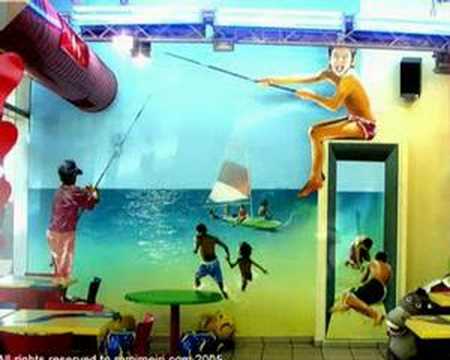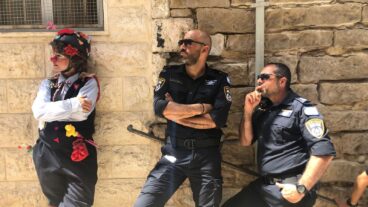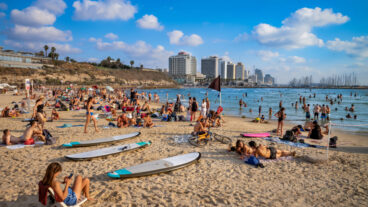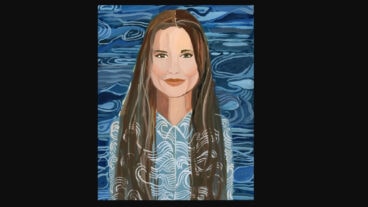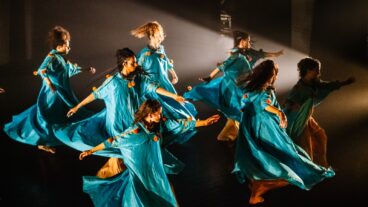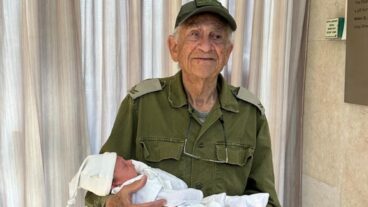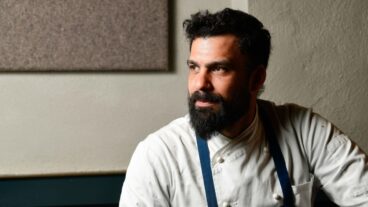One of Meiri’s early murals in Tel Aviv – ‘Tel Aviv needed some beauty and I needed the exposure.’Rami Meiri is tired. The Israeli artist spent the weekend applying his signature outdoor mural style to post-war Kiryat Shmona on the Israel-Lebanon border and he’s been on the phone all morning with contacts in Taipei discussing details of an impending Taiwan project. Over the past few months he has traveled to Beijing, Buenos Aires and the US and currently he’s in Tel Aviv completing a commissioned Tel Aviv highway overpass.
“I’m an urban artist. My language is visual,” Meiri self-describes his talent for creating evocative, larger-than-life murals. Meiri’s bright, acrylic works mirror Israel’s lighter side portraying pub culture, nightlife and images of beachgoers lazing in the sand. Splashed across the country’s breakfronts, building facades and cultural centers, his work is now beginning to turn up abroad.
In May, Meiri was commissioned by Israel’s embassy in China to paint a mural on the wall surrounding a Beijing elementary school. As part of the embassy’s “Join Hands Facing the New Countryside” initiative, Meiri spent several weeks in China observing and painting.
“I don’t speak Chinese and the school children didn’t speak Hebrew or English. They would come watch me work but we couldn’t communicate formally. So I resorted to telling them stories in Hebrew. They listened, laughed and responded. Then one day they showed up with tape across their mouths. The message was clear: ‘No Hebrew’,” Meiri tells ISRAEL21c.
The ongoing government initiative aimed at sharing agricultural, cultural, health and technological know-how with China’s developing rural areas was timed to coincide with Israeli Independence Day in May. Israeli Ambassador to China Dr. Yehoyada Haim said the $62,000 donated to the project came from “… the embassy and twenty Israeli companies and individuals.”
Meiri says his part was to spread goodwill and cheer, something he has been doing inside Israel for decades. He painted his first mural along Tel Aviv’s beachfront in the ’80s while completing an art degree at Tel Aviv’s Avni Institute – “Tel Aviv needed some beauty and I needed the exposure” – and his quick sketch technique of capturing the lighter side of people in motion quickly caught on. He has been busy over the past few decades creating dozens of murals in and outside of Israel.
As major influences he cites Keith Haring and South America. “Haring had half a minute to capture subway trains and passengers so he wouldn’t get caught. He used simple lines and strokes. I relate to that minimalism. I don’t use a lot of background detail in my work. South America, on the other hand, was where I traveled after my army service. The dancing, happiness and energy affected my style. One of my favorite themes is Carnival.”
Meiri’s talent for portraying life’s lighter side has been a major factor in ongoing commissioned work. He says that despite Israel’s political climate and his personal aversion to things political, he harbors a need to shoulder responsibility.
“When a war is on, it’s my war too,” he says. “It’s my job to give people a feel of return-to-normal even if life hasn’t returned to a so-called normal state after war. Last week I worked on a youth cultural center in Kiryat Shmona. The war is over, the buildings are fixed up but something inside the people hasn’t come back yet. It’s my job to help bring it back.”
During the 1991 Gulf War, Meiri was commissioned to mural in a Tel Aviv suburb hit by Scud missiles and during multiple suicide bombing campaigns in central Israel a few years back, he was asked to boost morale by applying his signature touch to a hugely visual, high rise office complex.
“This isn’t a normal country but if I give people the feeling that there’s still art and life going on then maybe they’ll feel okay about where they live,” Meiri explains.
Meiri’s work exhibited in Manhattan’s prestigious Bronfman Galleries last Spring as part of a graffiti artist collective showing there and he flew to Buenos Aires earlier in the year to help refurbish the AMIA (Argentine Israelite Mutual Association) building bombed by Hizbullah in 1994.
“When I finished my work on the AMIA building, I was asked to sign the guest book. I browsed through the book and there’s David Ben Gurion and Yitzhak Rabin and Zalman Shoval. You can imagine how I felt,” Meiri muses. When creating works abroad, he always signs his pieces ‘From Israel with Love’.
Of his somewhat old-fashioned sketch technique in the day of digital and Photoshop, Meiri readily admits to departing from old school in order to achieve professional goals. He uses a digital camera to photograph subjects, projects their images onto a studio wall using Power Point and refers to the projection as a visual aid while painting. When traveling, his laptop is an essential tool.
Regarding future projects and negotiation, Meiri remains eternally optimistic. “As I achieve my goals and dreams I find new ones to pursue,” he muses. “When I can’t do the huge murals anymore, I’ll probably end up sitting on the beach boardwalk and sketching people as they go by. I love the dialogue and inter-connectedness. It keeps me happy.”




